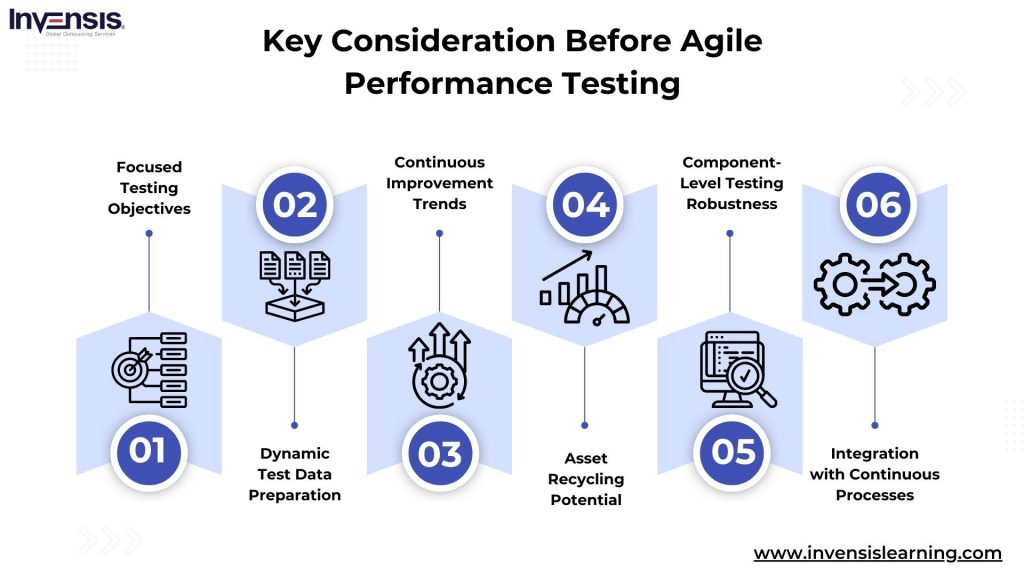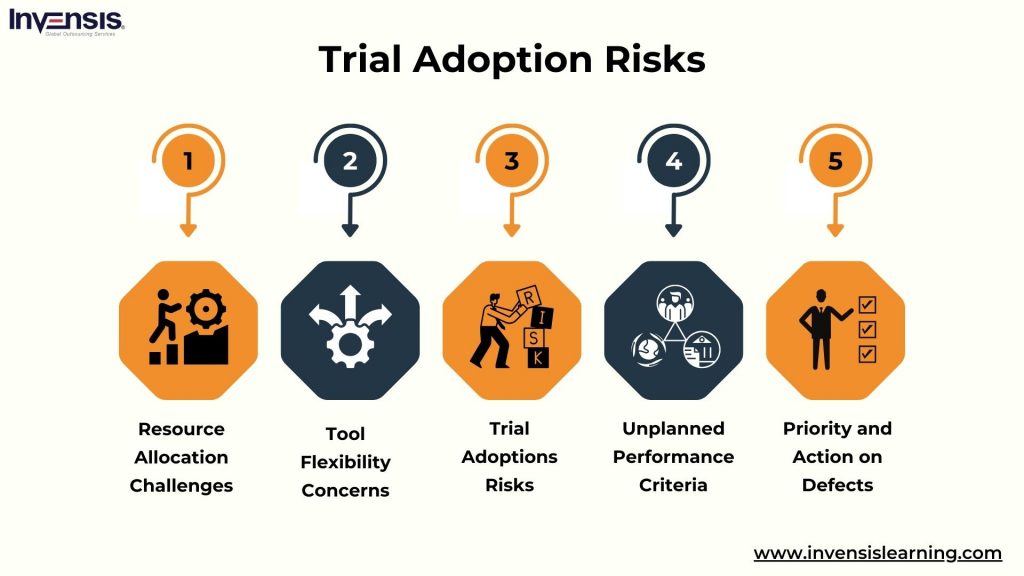
In Agile development, ensuring your software performs optimally is paramount. This blog breaks down essential strategies, from early testing integration to iterative refinement, providing a clear roadmap for incorporating performance testing into Agile methodologies.
Join us as we navigate the practical steps and key principles to enhance your software’s performance in the Agile environment.
Let’s dive in and streamline your approach to achieving excellence in Agile performance testing!
Table of Contents:
- What is an Agile Environment?
- Key Consideration Before Agile Performance Testing
- Benefits of Agile Performance Testing
- Agile Performance Testing Best Practices
- Factors Affecting Performance Testing in Agile Environment
- Popular Tools to Use for Performance Testing
- Conclusion
What is an Agile Environment?
An Agile environment is a collaborative and iterative approach to software development and project management that emphasizes flexibility, adaptability, and customer satisfaction. In an Agile environment, cross-functional teams work together in short cycles or iterations, known as sprints, to deliver incremental and functional pieces of a project.
The Agile methodology is based on the Agile Manifesto, prioritizing individuals and interactions, working solutions, and customer collaboration over rigid processes and extensive documentation.
- Iterative Development: Projects are divided into small, manageable iterations or sprints, typically lasting two to four weeks. A potentially shippable product increment is delivered at the end of each iteration.
- Flexibility and Adaptability: Agile methodologies like Scrum and Kanban emphasize adaptability to changing requirements. Teams are encouraged to respond quickly to feedback and adjust priorities accordingly.
- Collaboration: Cross-functional teams comprising developers, testers, and other relevant roles work closely together. Communication and collaboration are prioritized to foster a shared understanding of project goals.
- Customer Involvement: Customer feedback is sought and valued throughout the development process. This ensures that the delivered product aligns with customer expectations and requirements.
- Continuous Improvement: Agile teams regularly reflect on their processes and performance, aiming for continuous improvement. Retrospectives and feedback loops are common practices to refine workflows.
Key Consideration Before Agile Performance Testing
In an Agile setup, those overseeing the application development seek a continual uptrend in performance across successive sprints. The aim is to witness incremental improvements or maintain stability with each iteration.
Monitoring application performance against predefined Service Level Objectives (SLOs) becomes crucial.
Trending reports offer a brief yet insightful overview, providing stakeholders with regular snapshots of the application’s performance trajectory.
This approach eliminates the need for an exhaustive analysis after each test run, simplifying tracking and understanding the application’s performance trends over time.
-
Focused Testing Objectives
Instead of adopting big bang approaches, Agile performance testing should be tailored to focus on specific areas, aligning with the incremental nature of Agile development. This targeted approach ensures that performance testing efforts are efficient and directly contribute to the ongoing development goals.
-
Dynamic Test Data Preparation
Given the need for frequent changes in Agile sprints, agile performance testing requires proactive preparation of test data that aligns with the evolving requirements of each sprint. This adaptive approach ensures that performance tests are conducted using relevant and realistic data, mirroring the dynamic nature of the Agile process.
-
Continuous Improvement Trends
In parallel with Agile’s emphasis on continuous development, Agile performance testing should also focus on continuous improvement. Establishing a trend analysis framework allows teams to identify patterns and trends in performance metrics, enabling proactive adjustments and enhancements to the testing strategy.
-
Asset Recycling Potential
Performance test suites should strive for reusability to minimize disruption and achieve stability. While the payload may undergo significant changes between sprints, reusable assets ensure that the testing infrastructure remains adaptable to evolving software components.
-
Component-Level Testing Robustness
Recognizing that sprints often involve adjustments to internal components, a robust performance test suite should validate tier-level performance. Component-level performance testing ensures that changes to individual features and internal components do not negatively impact the overall system performance.
-
Integration with Continuous Processes
Continuous integration practices are vital for Agile performance testing. Unattended performance tests should be integrated into the continuous build and deployment systems, allowing automated execution after logical check-ins and drops. This integration supports the Agile principle of delivering working software at the end of each iteration.
Benefits of Agile Performance Testing
Integrating Agile principles into performance testing has ushered in a host of benefits, revolutionizing efficiency in the realm of technological innovations. Agile performance testing proves instrumental in creating more reliable products, preemptively addressing potential user experience challenges.
The advantages of embracing Agile performance testing are multifaceted.
-
Enhanced Efficiency
Agile testing injects speed and efficiency into test strategies, fostering frequent test cycles and adeptly addressing even minor code adjustments. This approach streamlines testing updates, ensuring a manageable and smooth workflow throughout the Software Development Life Cycle (SDLC).
-
Effective Capacity Management
Agile performance testing simplifies capacity management by verifying and validating the hardware and software used in development. This information facilitates tasks such as load testing, stress testing, and soak testing, enabling the effective handling of memory issues, defects, and other potential challenges.
-
Accelerated Test Execution
Agile methodology accelerates performance testing sprints by allowing the emulation of various user scenarios. This proactive approach assists in predicting and addressing potential use cases, contributing to customer support goals and overall technology effectiveness.
-
Adaptability to Unknown Scenarios
Recognizing the difficulty in predicting every possible use case, Agile performance testing excels in identifying maximum unknown scenarios and documenting them effectively. This flexibility facilitates efficient issue resolution, ultimately enhancing the end-user experience.
-
Cost Savings through Full-Cycle Testing
Agile methodology emphasizes full-cycle testing expedites performance testing sprints, resulting in time and cost savings associated with changes. By reducing the feedback cycle, Agile performance testing aids in determining the scope for developed features and mitigates the cost of change.
-
Elevated Product and Brand Value
Agile performance testing aligns product development with user requirements and branding goals, culminating in a product that meets customer expectations. This not only improves customer retention rates but also reduces the occurrence of support tickets, phone calls, or queries stemming from any product functionality issues.
Agile Performance Testing Best Practices
Implementing Agile performance testing involves adopting specific strategies and practices to ensure efficiency, early issue detection, and continuous improvement. Here are tips and best practices aligned with Agile principles.
Make Testing Easier
Testing doesn’t have to be complicated. Learn the concept of “Shift Left” and discover why starting tests early in the development cycle can make the entire process smoother. Unlike traditional methods, where testing comes after development, Agile encourages early and continuous testing. Address performance issues from the start to avoid potential challenges later on.
Automate with CI/CD
Simplify testing by automating with CI/CD pipelines. See how integrating performance tests with every code commit or at scheduled intervals becomes a natural part of the development workflow. Automation saves time and reduces errors, providing rapid feedback to the development team.
Set Clear Goals
Unlock the power of clear objectives. Define Key Performance Indicators (KPIs) that align with your application and user requirements. These KPIs become benchmarks, guiding your performance testing process and enabling informed decision-making based on measurable and predefined criteria.
Test Like the Real World
Discover the importance of using realistic test data and scenarios. Learn how analyzing user behavior and product data helps create test scenarios mirroring usage patterns. Explore various testing techniques, including load and stress testing, for a comprehensive assessment under different conditions.
See It Live with Monitoring
Experience real-time insights with monitoring during performance tests. Understand how using performance testing tools or external solutions like Grafana and Prometheus helps collect and visualize key metrics. Analysis becomes a breeze, allowing you to interpret data and identify bottlenecks, irregular patterns, and potential performance issues.
Team Up for Success
Learn why collaboration is key in Agile performance testing. Explore how regular communication, shared documentation, and collective decision-making ensure everyone is on the same page regarding performance requirements. Effective collaboration accelerates time-to-market and boosts overall team satisfaction and productivity.
Adapt and Optimize
Embrace an iterative approach to testing. See how using data from each testing cycle helps optimize code and testing procedures. If a test reveals a backup, address it and retest to confirm the solution’s effectiveness. Continuous adaptation of the test suite accommodates changing project requirements, ensuring ongoing relevance and effectiveness.
Factors Affecting Performance Testing in Agile Environment
Effective performance testing in an Agile environment hinges on the strategic involvement of performance testers at the outset of each sprint and after the development cycle. This proactive engagement ensures product quality and facilitates timely releases without unnecessary delays. However, several factors can impact the success of performance testing in Agile.
-
Resource Challenges
The scarcity of experienced performance testing professionals, especially for critical projects, can pose a significant hurdle. Acquiring skilled resources becomes crucial to uphold the quality assurance of the product throughout the Agile development process.
-
Tool Flexibility Concerns
Clients’ concerns regarding the flexibility of performance testing tools may impede testing efforts. Overcoming tool-related limitations is essential to meet project requirements and deliver robust performance assessments.
-
Trial Adoptions Risks
Experimenting with performance testing in select critical Agile projects may unveil unforeseen challenges. Trial adoptions risk specific performance issues emerging, necessitating careful consideration and adaptation.
-
Unplanned Performance Criteria
In some Agile projects, comprehensive criteria for performance testing may not be adequately planned for each sprint. Proper planning and defining performance criteria are vital to ensure meaningful and targeted performance assessments throughout the development lifecycle.
-
Priority and Action on Defects
The lack of prioritization by project teams to promptly handle performance defects can hinder the effectiveness of performance testing efforts. Swift and decisive action on identified performance issues is essential to maintain project momentum and deliver a high-quality product.
Popular Tools to Use for Performance Testing
Several popular tools are available for performance testing, each with its own features and capabilities. The choice of tool often depends on the specific needs, preferences, and requirements of the testing team and the project. Here are some widely used performance testing tools.
-
Apache JMeter
An open-source tool, Apache JMeter, is widely used for performance and load testing. It allows testers to simulate various scenarios and assess the performance of web applications, databases, and other services.
-
LoadRunner
Developed by Micro Focus, LoadRunner is a robust performance testing tool used to simulate user behavior and workload to assess the performance of applications under different conditions. It supports various protocols, including HTTP, HTTPS, and more.
-
NeoLoad
NeoLoad is a performance testing tool that focuses on creating realistic user scenarios and simulating virtual users to evaluate the performance of web and mobile applications. It provides insights into response times, throughput, and server health.
-
Gatling
Gatling is an open-source performance testing tool that uses Scala programming language. It is designed for ease of use and allows testers to script performance tests as code. Gatling is known for its flexibility and support for various protocols.
-
Apache ab (Apache Benchmark)
Apache ab is a simple command-line tool with the Apache HTTP server package. It is suitable for basic performance testing and benchmarking of web servers by sending a specified number of requests to a target web server.
-
BlazeMeter
BlazeMeter is a cloud-based performance testing platform that enables testers to create, run, and analyze performance tests at scale. It supports various testing types, including load, stress, and continuous testing.
-
Locust
Locust is an open-source performance testing tool written in Python. It allows testers to define user behavior using Python code and simulate many concurrent users to evaluate the performance of web applications.
-
Artillery
Artillery is an open-source, modern, and flexible performance testing tool. It allows testers to define test scenarios using YAML or JavaScript and supports protocols like HTTP and WebSocket. Artillery focuses on simplicity and extensibility.
-
WebLOAD
WebLOAD is a performance testing tool that supports many web and mobile protocols. It allows testers to create complex scenarios and simulate virtual users to assess the scalability and performance of applications.
-
K6
K6 is an open-source performance testing tool that focuses on developer-centric performance testing. It allows testers to write test scripts in JavaScript and execute tests from the command line or integrate them into CI/CD pipelines.
Conclusion
Conducting Agile performance testing is essential for ensuring the seamless integration of performance assessments within the iterative and dynamic Agile development environment.
By embracing early testing, integrating into CI/CD pipelines, defining clear objectives, using realistic test data, monitoring, collaborating effectively, and iterating based on insights, teams can enhance their software development processes’ quality, efficiency, and responsiveness.
When implemented with these key principles, Agile performance testing becomes a catalyst for delivering high-performing software that aligns with user expectations and adapts to evolving project needs.
Advance your career in project management with Invensis Learning’s Agile Certification courses. Gain comprehensive insights into Agile methodologies, master adaptive project management, and enhance your skills for successful project delivery. Enroll now and empower your journey towards becoming a certified AgilePM professional.
















